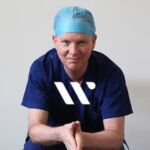
Every plastic surgeon needs to learn from others and one of my greatest influences in the area of facial rejuvenation surgery has been Dr Bryan Mendelson, a Melbourne plastic surgeon.
My generation of plastic surgeons and surgeons worldwide who come after us owe him a debt for his lifetime career contribution. Bryan has played a critical role in extending the knowledge base of complex facial anatomy as it applies to facial rejuvenation surgery.
He has evolved methodology and techniques in facelift surgery based on science, knowledge, experience and facts rather than the less rigorous approach surgeons previously took to this area. His unique contribution has been that he is a surgeon who has become an anatomist. This allows him to develop insight into the anatomy of the face as it applies to appearance – unlike a pure anatomist who would just describe the structures, but not be able to translate that knowledge into a technique which could help people. Bryan is still in full time practice in Melbourne, where he only undertakes facial aesthetic surgery. His work is an inspiration to plastic surgeons worldwide with an interest in facial rejuvenation surgery.
Bryan’s insights into facial surgery have earned him a global reputation and he is invited all around the world to teach facial anatomy every year. About 10 years ago, he and some other plastic surgeons based in Melbourne developed the MAFAC course a Melbourne-based course in facial anatomy developed specifically for practicing Plastic Surgeons or Plastic Surgery Trainees in their final year. Today, he takes the course around the world, to the US in particular, for teaching American and international surgeons. Along with a number of other senior Australian and overseas plastic surgeons, it’s been my privilege to help him teach this course many times.
During the annual Australian course, practising and trainee surgeons learn how to dissect the face using surgical quality cadavers at the Royal Australasian College of Surgeons. This hands-on experience is vitally important to the evolution of facial rejuvenation technique because it helps to understand and operate safely on each of the facial layers, respecting the important facial nerve relationships and their applications.
Interacting with Bryan has been of tremendous value to me in terms of evolving my own technique and understanding of facial anatomy. I can honestly say that most of the changes I’ve made to my technique in the last few years have been due to his influence and learning.
Here are some other things you should know about Bryan. He has a global audience that is keen to learn the results of his 25 years of original research into facial anatomy and the origin and development of facial ageing. He has performed live surgical demonstrations of the facelift in countries around the world, including London, Cologne, Istanbul, Moscow, Bangkok and Brazil.
He has given more than 100 presentations to plastic surgical colleagues around the world. The Bryan C Mendelson Medal was named in recognition of his lifetime of teaching and surgery and is awarded for the best STOCS (short talk on cosmetic surgery) presentation to the Australasian Society of Aesthetic Plastic Surgeons annually.
The bottom line is that Bryan is not alone working in this field. Progressively advancing knowledge of facial anatomy and of techniques developed by Bryan and other surgeons around the world is vital to help us improve the quality of our work as surgeons. Just as importantly, it helps us learn new techniques that we can safely use to provide the best results for our patients that are possible.





